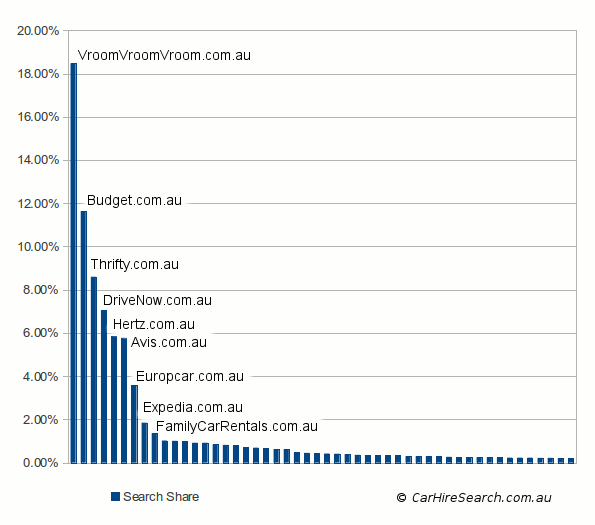In June 2013 Road Genius conducted a study to find out which Australian car rental sites are having the most success with attracting visitors organically through Google Search. The goal of the project was to compare how well individual brands are coping with the ongoing trend of customers moving on-line with travel shopping and to find out which companies are taking the fullest advantage of organic Google Search traffic.
As part of the study we checked who ranks on the first two pages in Google.com.au for nearly one thousand keywords. After combining the collected rankings we used Google traffic volumes and a combination of two independent click-through models to estimate how traffic is distributed across the surveyed websites. Here are the results.
Google Search Traffic Distribution
Across Top Car Hire Sites in Australia

Each column represents the share of Google search traffic received from 997 car rental related keywords. Rankings were checked on 26th June 2013 in Google.com.au.
Highlights
- 7 car rental websites receive over 60% of organic Google Traffic from the surveyed keywords.
- Among the top 7 sites there are five global brands (Budget, Thrifty, Hertz, Avis, Europcar) and two comparison sites (VroomVroomVroom.com.au and DriveNow.com.au).
- The leader in organic traffic volume, VroomVroomVroom.com.au receives 50% more visits from Google.com.au than the next most popular website Budget.com.au.
Study Methodology
The rankings were checked in Google.com.au over an 8 hour period on 26th June 2013 with disabled personalization. For each of the 997 keywords checked we collected average monthly search volumes via the Google Adwords Keyword Tool.
Rankings at the top of a search result page (SERP) receive in general significantly more visits than lower ranked results, so we used a SERP click-through rate (CTR) model to estimate traffic volumes for each website-keyword pair. Our SERP CTR values were base on two studies: one conducted by Slingshot SEO in July 2011 (PDF) and a recent study published in June 2013 by Chitika. We chose these two as both are backed by sound (and differing) methodologies and both show very similar results after normalizing. Additionally, the Slingshot model was created by comparing Google Adwords Keyword Tool data to real traffic volumes, so it was well suited to the reverse process of arriving at traffic estimates based on click-through rates and Google Adwords Keyword Tool search volume data.
Limitations
Our study did not include Google searches for brand names. We decided to leave these out due to the potential difficulty in interpreting user-intent of searches. For example a search for “Budget” might indicate a search for a car rental brand, but it could alternatively be a search for an insurance brand or the generic term “budget”. Branded searches often make-up a non-trivial portion of a website’s organic search referrals.
Positions in Google fluctuate on a constant basis as the search engine re-evaluates ranking signals and updates its index. While we have provided a snap-shot of how the car rental industry is performing in Google Australia, in the future we may look into aggregating similar data across a larger time-frame.
